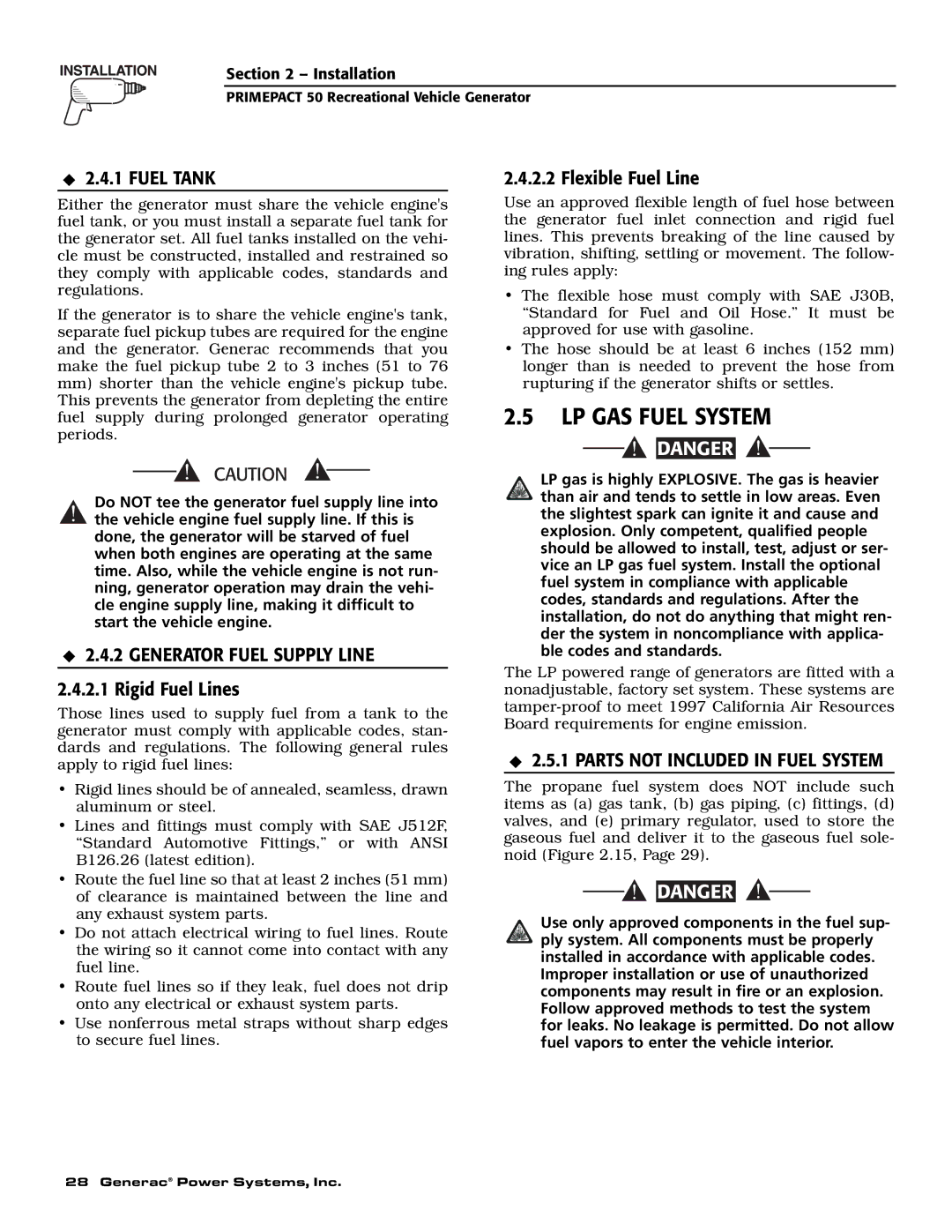
Section 2 – Installation
PRIMEPACT 50 Recreational Vehicle Generator
◆ 2.4.1 FUEL TANK | 2.4.2.2 Flexible Fuel Line |
Either the generator must share the vehicle engine's fuel tank, or you must install a separate fuel tank for the generator set. All fuel tanks installed on the vehi- cle must be constructed, installed and restrained so they comply with applicable codes, standards and regulations.
If the generator is to share the vehicle engine's tank, separate fuel pickup tubes are required for the engine and the generator. Generac recommends that you make the fuel pickup tube 2 to 3 inches (51 to 76
mm)shorter than the vehicle engine's pickup tube. This prevents the generator from depleting the entire fuel supply during prolonged generator operating periods.
Do NOT tee the generator fuel supply line into
!the vehicle engine fuel supply line. If this is done, the generator will be starved of fuel when both engines are operating at the same time. Also, while the vehicle engine is not run- ning, generator operation may drain the vehi- cle engine supply line, making it difficult to start the vehicle engine.
◆2.4.2 GENERATOR FUEL SUPPLY LINE
2.4.2.1 Rigid Fuel Lines
Those lines used to supply fuel from a tank to the generator must comply with applicable codes, stan- dards and regulations. The following general rules apply to rigid fuel lines:
•Rigid lines should be of annealed, seamless, drawn aluminum or steel.
•Lines and fittings must comply with SAE J512F, “Standard Automotive Fittings,” or with ANSI B126.26 (latest edition).
•Route the fuel line so that at least 2 inches (51 mm) of clearance is maintained between the line and any exhaust system parts.
•Do not attach electrical wiring to fuel lines. Route the wiring so it cannot come into contact with any fuel line.
•Route fuel lines so if they leak, fuel does not drip onto any electrical or exhaust system parts.
•Use nonferrous metal straps without sharp edges to secure fuel lines.
Use an approved flexible length of fuel hose between the generator fuel inlet connection and rigid fuel lines. This prevents breaking of the line caused by vibration, shifting, settling or movement. The follow- ing rules apply:
•The flexible hose must comply with SAE J30B, “Standard for Fuel and Oil Hose.” It must be approved for use with gasoline.
•The hose should be at least 6 inches (152 mm) longer than is needed to prevent the hose from rupturing if the generator shifts or settles.
2.5LP GAS FUEL SYSTEM
![]()
![]() DANGER
DANGER
LP gas is highly EXPLOSIVE. The gas is heavier than air and tends to settle in low areas. Even the slightest spark can ignite it and cause and explosion. Only competent, qualified people should be allowed to install, test, adjust or ser- vice an LP gas fuel system. Install the optional fuel system in compliance with applicable codes, standards and regulations. After the installation, do not do anything that might ren- der the system in noncompliance with applica- ble codes and standards.
The LP powered range of generators are fitted with a nonadjustable, factory set system. These systems are
◆2.5.1 PARTS NOT INCLUDED IN FUEL SYSTEM
The propane fuel system does NOT include such items as (a) gas tank, (b) gas piping, (c) fittings, (d) valves, and (e) primary regulator, used to store the gaseous fuel and deliver it to the gaseous fuel sole- noid (Figure 2.15, Page 29).
![]()
![]() DANGER
DANGER
Use only approved components in the fuel sup- ply system. All components must be properly installed in accordance with applicable codes. Improper installation or use of unauthorized components may result in fire or an explosion. Follow approved methods to test the system for leaks. No leakage is permitted. Do not allow fuel vapors to enter the vehicle interior.
28 Generac® Power Systems, Inc.
